Indexed In
- RefSeek
- Hamdard University
- EBSCO A-Z
- Publons
- Euro Pub
- Google Scholar
Useful Links
Share This Page
Journal Flyer

Open Access Journals
- Agri and Aquaculture
- Biochemistry
- Bioinformatics & Systems Biology
- Business & Management
- Chemistry
- Clinical Sciences
- Engineering
- Food & Nutrition
- General Science
- Genetics & Molecular Biology
- Immunology & Microbiology
- Medical Sciences
- Neuroscience & Psychology
- Nursing & Health Care
- Pharmaceutical Sciences
Perspective - (2024) Volume 9, Issue 6
Diagnostic Approaches to Schistosomiasis: Enhancing Detection and Control in Endemic Areas
Pauling Rein*Received: 28-Oct-2024, Manuscript No. JIDD-24-27711; Editor assigned: 30-Oct-2024, Pre QC No. JIDD-24-27711 (PQ); Reviewed: 14-Nov-2024, QC No. JIDD-24-27711; Revised: 21-Nov-2024, Manuscript No. JIDD-24-27711 (R); Published: 29-Nov-2024, DOI: 10.35248/2576-389X.24.09.303
Description
Schistosomiasis, also known as bilharzia, is a parasitic disease caused by trematode flatworms of the genus Schistosoma. It is a significant public health issue in many tropical and subtropical regions, particularly in areas with inadequate access to clean water and sanitation. According to the World Health Organization (WHO), more than 200 million people are infected worldwide, with the majority living in Sub-Saharan Africa. The disease is linked to significant morbidity and poses economic and social burdens in affected communities. Early and accurate diagnosis is vital for managing schistosomiasis effectively and minimizing its impact.
Life cycle and transmission
The Schistosoma species that cause human disease include S. haematobium, S. mansoni and S. japonicum. The parasite’s life cycle involves two hosts: Freshwater snails and humans. Infection begins when humans come into contact with freshwater contaminated with the cercariae stage of the parasite. The cercariae penetrate the skin, enter the bloodstream and migrate to the liver, where they mature into adult worms. These worms then travel to their preferred sites, such as the blood vessels of the intestines or bladder, where they produce eggs.
The eggs can cause a variety of symptoms, depending on where they are deposited. Some are excreted through urine or feces, continuing the transmission cycle when they reach freshwater. Others become trapped in host tissues, leading to inflammation and long-term complications such as bladder cancer, liver fibrosis and portal hypertension.
Diagnostic methods
Diagnosing schistosomiasis requires methods that detect the parasite or its eggs, as well as those that assess the host's immune response. The choice of diagnostic tool depends on factors such as the species of Schistosoma, disease phase and resources available.
Microscopy: Microscopy is the most commonly used diagnostic method in endemic areas due to its simplicity. Eggs of S. haematobium can be identified in urine samples, while S. mansoni and S. japonicum eggs are detected in stool samples. Techniques such as the Kato-Katz method enhance egg detection in stool samples by providing a standardized approach to quantification. However, this method has limited sensitivity, particularly in individuals with light infections or during non-egg-producing phases of the parasite’s life cycle.
Serological tests: Antibody-based tests are useful for detecting past or current exposure to Schistosoma. Enzyme-Linked Immunosorbent Assays (ELISAs) and immunoblots are common examples. These tests are highly sensitive and can detect infections even in individuals with low parasite loads. However, they cannot distinguish between active and past infections, limiting their utility in certain contexts.
Antigen detection: Circulating antigens, such as Circulating Anodic Antigen (CAA) and Circulating Cathodic Antigen (CCA), offer an alternative approach to diagnosis. Tests targeting these antigens are more specific to active infections compared to antibody-based methods. The CCA urine test is particularly promising for diagnosing S. mansoni infections due to its non- invasive nature and ease of use. Despite this, antigen detection methods require further refinement to improve their sensitivity and applicability for all Schistosoma species.
Molecular diagnostics: Polymerase Chain Reaction (PCR) assays provide high sensitivity and specificity by detecting Schistosoma DNA in clinical samples, such as urine, stool, or blood. These methods are valuable for detecting low-intensity infections and mixed infections involving multiple species. However, their high cost and need for advanced laboratory infrastructure limit their widespread use in resource-limited settings.
Imaging techniques: Imaging modalities such as ultrasound and Computed Tomography (CT) are used to evaluate complications of chronic schistosomiasis. Ultrasound is particularly useful for assessing liver and bladder pathology in endemic areas. These techniques are not diagnostic but provide complementary information about disease severity and prognosis.
Challenges and future directions
Diagnosing schistosomiasis remains challenging in many endemic regions due to limited resources, variability in test sensitivity and the need for species-specific approaches. Innovations in diagnostics aim to address these challenges by developing methods that are affordable, sensitive and field- friendly. Point-of-Care Tests (POCTs) hold promise for expanding access to timely diagnosis in remote areas.
Moreover, integrating diagnostic tools with public health initiatives, such as Mass Drug Administration (MDA) campaigns, could enhance disease surveillance and control efforts. Combining diagnostics with genomic and proteomic research may also lead to the identification of novel biomarkers, improving both diagnostic accuracy and understanding of disease mechanisms.
Conclusion
Schistosomiasis remains a significant health burden in many parts of the world. Effective diagnosis is essential for managing and controlling this parasitic disease. A combination of traditional methods like microscopy and newer techniques such as antigen detection and molecular diagnostics can help improve diagnostic accuracy. Ongoing research and investment in diagnostic innovation, coupled with public health interventions, are important for reducing the impact of schistosomiasis globally.
Citation: Rein P (2024). Diagnostic Approaches to Schistosomiasis: Enhancing Detection and Control in Endemic Areas. J Infect Dis Diagn. 9:303.
Copyright: © 2024 Rein P. This is an open-access article distributed under the terms of the Creative Commons Attribution License, which permits unrestricted use, distribution and reproduction in any medium, provided the original author and source are credited.

